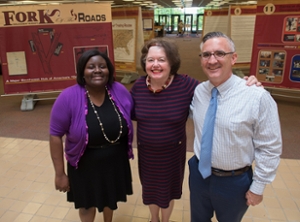 The historic and largely untold dark story about the second largest slave trading market in America before the Civil War, which operated in Natchez, Miss., is on display at Southern Illinois University Edwardsville’s Elijah P. Lovejoy Library.
The historic and largely untold dark story about the second largest slave trading market in America before the Civil War, which operated in Natchez, Miss., is on display at Southern Illinois University Edwardsville’s Elijah P. Lovejoy Library.
The curator of the exhibit, Ser Seshsh Ab Heter—Clifford M. Boxley, will be on campus from Monday, Sept. 12-Thursday, Sept. 15. A grant from the College of Arts and Sciences Targeted Funding Initiative provided the funds to bring both the exhibit and Boxley to campus.
Boxley, who holds a master’s in urban and regional planning, will give a presentation at 4:30 p.m. Tuesday, Sept. 13 in the Lovejoy Library.
Forks of the Roads Enslavement Markets traveling exhibition was set up in Lovejoy on June 10 and will remain at the library for one year, thanks to the efforts of three SIUE instructors in the Department of Historical Studies: Jessica Harris, PhD, assistant professor; Rowena McClinton, PhD professor; and Bryan Jack, PhD, associate professor.
The 12-panel exhibit is the result of the exhaustive research and dogged determination of Boxley to make the once lucrative slave trading post in his hometown of Natchez, a national historic landmark.
“We thought it was critical to bring both the exhibit and Mr. Ser Seshsh Ab Heter-Clifford M. Boxley to campus,” said Harris. “As much as has been written about slavery and racism, there is still much to discover and still more work to do.”
However, the professors’ good fortune of securing Boxley to come to SIUE came about as happenstance. They wrote an Excellence in Undergraduate Education grant in fall 2014 and were awarded $18,000 to take students on a civil rights trip. In the summer of 2015, Harris, McClinton and Jack took eight students who had expressed an interest in touring various civil rights historic landmarks in Mississippi.
“Most people are familiar with the transatlantic slave trade,” said Jack, “but the internal slave trade was just as devastating and important, and we wanted to expose our students to it.” Jack and his wife had previously visited Natchez and discovered the Forks in the Road monument. He suggested visiting the site as part of the group’s civil rights trip.
“Mr. Boxley happened to be passing by when we were at the site,” McClinton said. “He stopped and gave us detailed information.”
“It’s important that we let our students know about the country’s past, the institution of slavery and the incredible effects it has had on those who are of African descent,” McClinton continued, “and how it created white supremacy in the Deep South. It is crucial that we honor them. These were real people with real lives, who were in forced into involuntary slavery. Their memories and contributions are just as important in the historic record.”
The Forks of the Road intersection appears in maps of Natchez as early as 1808. But from approximately 1833 until the Civil War, the location was a huge slave market located at the intersection of Liberty Road and St. Catherine Street. The importance of this slave market increased dramatically when Isaac Franklin of Tennessee rented property there. He and his business partner, John Armfield of Virginia, became the most active slave traders in the country.
Photo:
L-R: Shown among the Forks of the Roads Enslavement Markets traveling exhibition curated by Ser Seshsh Ab Heter-Clifford M. Boxley are SIUE instructors in the Department of Historical Studies:
Jessica Harris, PhD, assistant professor; Rowena McClinton, PhD, professor; and Bryan Jack, PhD, associate professor.